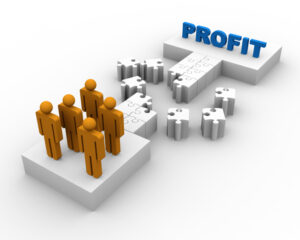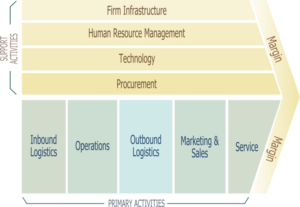How would you describe the linkage between your company's value chain, business strategy  and profits? This article, the fourth in our 5-part series, The 5 Keys to Strategy Execution, focuses on how managers can use the value chain diagram to develop their strategic differentiation and build profits.
and profits? This article, the fourth in our 5-part series, The 5 Keys to Strategy Execution, focuses on how managers can use the value chain diagram to develop their strategic differentiation and build profits.
The chart above is Michael Porter's, and it can be used as a framework to create a value chain map either from scratch or based on an existing value stream map.

Michael Porter's Value Chain
Value stream mapping is a lean manufacturing technique to identify, document and analyze the flow of materials and information required to bring a product or service to the customer. It is said that value stream mapping originated at Toyota.
Organizations perform many activities in producing a product or service. Some activities add value for the customer, while others don’t add value but may be essential internally or even for legal compliance. A Value Chain map is a diagram of the flow of just the value-adding activities performed across your organization to bring a product or service to the customer. A value chain map is a powerful tool, that, when analyzed, can help to identify opportunities to create value for customers.
You can use it to create your differentiation strategy or to evolve it over time. There-in lies its power. While many companies have mapped their value streams to improve efficiency and cost, not as many have modeled their Value Chain and used it as the transformational tool it can be in strategy development and execution. You see, it’s all about the reason your business exists, why customers buy from you, and how you can both develop and strengthen your competitive advantage.
The value your business creates for the customer is the source of business profitability. Here’s the math:
Value created and sold - the cost of creating the value = your profit margin
As you increase the value you provide to the customer, you increase your profit potential and you build and strengthen your competitive advantage. Determining why customers buy from you and increasing your unique value are critical to success over time. Porter describes this very well in his book, “Competitive Advantage”.
Porter’s framework (above) enables you to categorize your organization’s activities as either Primary or Support. In his diagram, you see the support activities in yellow at the top i.e. Human Resources. The primary activities are then shown, i.e. Logistics. This helps you to break down the activities performed with a strategic perspective, to identify activities that drive value and cost. The benefit for you and your business is that you can then make high-impact decisions and changes based on information from key process drivers in your business (the support and primary activities on the map).
In summary, the Value Chain Map is a tool that managers can use to build and evolve your business strategy. It makes it easier to identify opportunities to provide value to your customers. The value that compels customers to buy from you generates profit potential. By increasing value provided to the customer your company can increase its profits.
When is the last time you evaluated your business strategy from the perspective of differentiation? What information was used? Was it a Value Chain Map? What were the results? Please share your experience, opinions and ideas.
Recommended Reading:
“Competitive Advantage” by Michael Porter
Our next article will focus on the 4th key to strategy execution, Metrics. The 5 Keys To Strategy Execution are:
- Strategic Understanding
- Leadership
- Activities and Structure
- Balanced Scorecard / Metrics
- Human Capital
Together with Market Discipline, the 5 keys comprise the recipe for successful strategic performance.
Latest posts by Rosanna Nadeau, PCLEC (see all)
- Is Quality Being Lost In Today’s Quest For Efficient Execution? - August 31, 2023
- What is HR’s Strategic Role? - August 24, 2023
- Agility: The Ability to Zig and Zag - August 23, 2023












